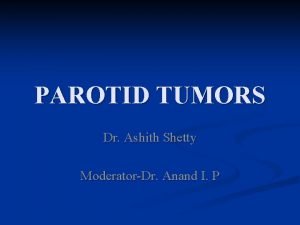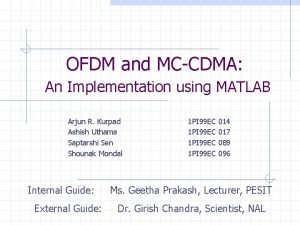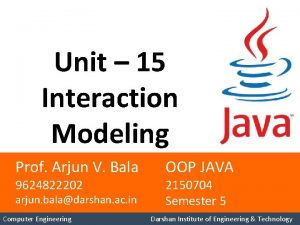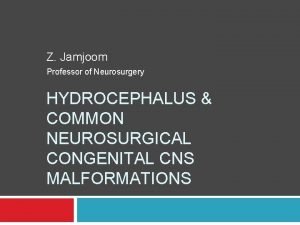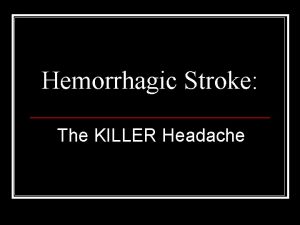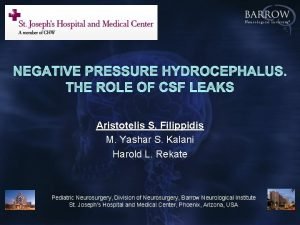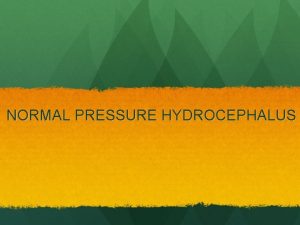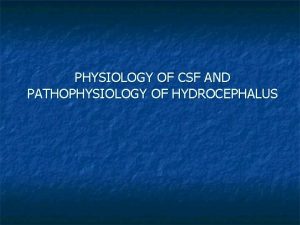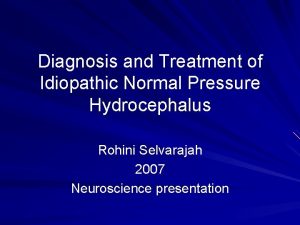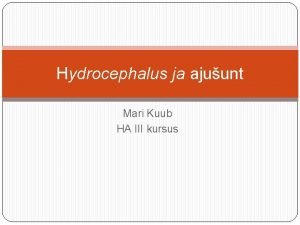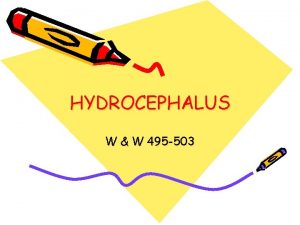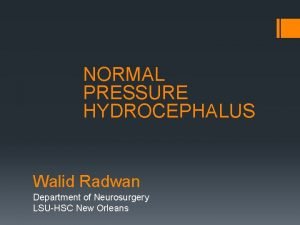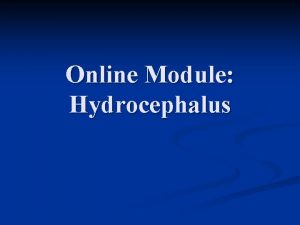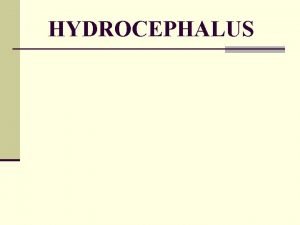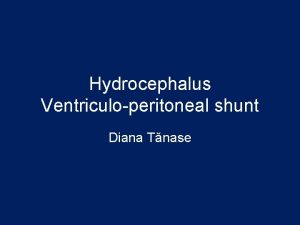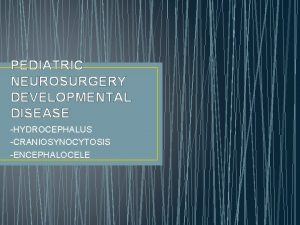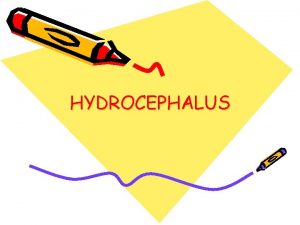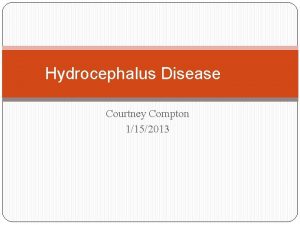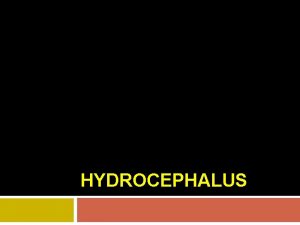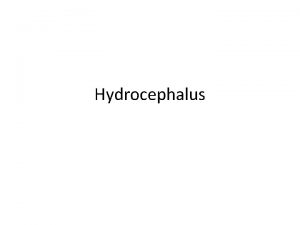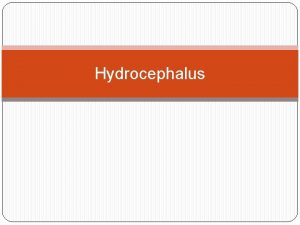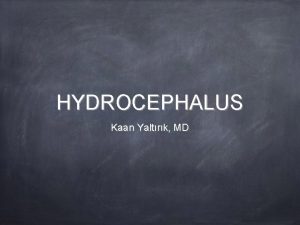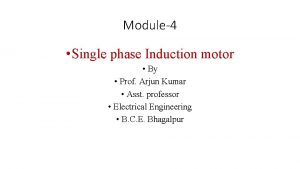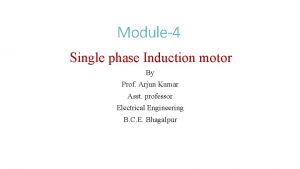HYDROCEPHALUS prof Dr Arjun Shetty Hydrocephalus is the



























- Slides: 27

HYDROCEPHALUS prof: Dr Arjun Shetty

• Hydrocephalus is the increased accumulation of csf in the brain • increased production of csf • decreased absorption of csf • obstruction to the flow of csf

• Increased production of csf Approximately ml of csf is present in an adult Rate of production of csf is ml per msq body surface area

• CSF is produced by an acute process in the choroid plexeus of the lateral ventricles. Passive production also occurs. • The production of csf is not sensitive to changes in ICP however absorption increases with raised ICP • CSF production is maximum at about 2 am and minimum at about 6 pm (3. 5 times)

• Factors affecting production: - drugs which decrease blood flow, eg. , vasopressin increase - Acetazolamide reduces csf production by uncoupling blood flow from csf production - Glycerol reducess csf production by increasing hyperosmolarity of blood - csf production is less in elderly patients copared to young patients

• Over production of csf: - choroid plexeus papilloma - choroid plexeus paapillitis

• Impared venous drainage : - csf is absorbed into the supra saggital sinus through the arachnoid granulations - upto a threshold point increase csf is associated with increased absorption of csf - Radical neck dissection , superior venacava obstruction , dural sinus thrombosis do not cause an increase in ventricular size in adults.

Obstruction to csf flow : CSF pathway : lateral ventricle I Foramen of Monro I 3 rd ventricle I Aqueduct of sylvius I 4 th ventricle I Foramen of Luscka and Magendie I Basal cisterns ( sub arachnoid space) I Superior sagital sinus Obstruction to flow : - from externally - from within the pathway

• Communicating and Non communicating hydrocephalus Hydrocephalus is considered to be communicating when the obstruction to flow of csf is in the subarachnoid space Non communicating hydrocephalus is when the csf flow is observed within the ventricular pathway itself

• Non communicating hydrocephalus Congenital : - aqueduct stenosis - Dandy Walker cyst - congenital cysts, tumors and arteriovenous malformations

• Acquired : - Aqueduct stenosis ( acquired ) - inflammation ( ventriculitis) - tumors : choroid cysts, intra and extra ventricular tumors - blood and other non neoplastic lesions

• Communicating hydrocephalus congenital : Arnold Chiari malformation Encephaloceles Absence of arachnoid granulations

• Acquired - Leptomeningeal inflammation due to infection, blood - Increased csf production due to SOL.

• Pathophysiology: 1. atrophy of white matter 2. oedema of brain surrounding the ventricles 3. fibrosis of choroid plexeus 4. stretched ependymal epithelium 5. ventricular diverticula, thinning of intra hemisphere commisures

• Acute hydrocephalus - intra ventricular haemorrage - sub arachnoid haemorrhage - head injuries – trans tentorial herniation - shunt obstruction

• ventricular dilatation occurs in 3 -6 hrs • lateral ventricle dialates first • aqueduct dialates last After 3 -6 hrs - ventricular enlargement slows down - ependymal thinning tears- edema, which is maximum by 24 hrs

• Chronic hydrocephalus Increase in csf is compensated by : -expansion of skull in infants -reduction of vascular volume - increased ventricular size - cerebral atrophy

• Damage to ependymal and choroid plexeus in chronic hydrocephalus reduces csf production • csf flow may be reversed in chronic communicating hydrocephalus

• Clinical features : in infants - cranio facial dysproportion - bulging fontanelle - dialated veins of scalp - sunset sign -crack pot sign -unilateral or bilateral 6 th nerve palsy - sutural diastasis

In adults : Acute cases- features of raised ICP, transient or sustained blindness, Perinauds syndrome

• Perinauds Syndrome :

• Chronic cases : - increased ICP - papilloedema and optic atrophy - decreased higher motor functions - 6 th nerve palsy - Perinauds syndrome - bitemporal hemianopia - spastic paraperesis with lesser upper limb involvement - endocrine abnormalities: precocious puberty, adiposogenital dystrophy, infantilism

• Normal pressure hydrocephalus : - chronic hydrocephlaus with normal csf pressure - small pressure gradient between venticles and brain - associated incomplete csf pathway obstruction

• Adults : - dementia - bladder incontinence - ataxia

• Children: - increase head size - mild mental retardation - mild spastic paraperesis

Diagnosis : - CT, MRI - iv pressure recording - clinical response to ventricular damage

• Arrested hydrocephalus : - csf pressure returns to normal - no ventricle-brain pressure gradient - associated partial obstructioncommonly distal If ventricles are enlarged without central atrophy – shunt could be considered in children
 Dr arjun shetty
Dr arjun shetty Building references
Building references Ravindra shetty
Ravindra shetty Dr shashikant shetty
Dr shashikant shetty Safaf
Safaf Natasha shetty
Natasha shetty Shashi kiran shetty net worth
Shashi kiran shetty net worth What does a nerve look like
What does a nerve look like Nths cord
Nths cord Arjun vachhani
Arjun vachhani Arjun matlab
Arjun matlab Arjun lahiri
Arjun lahiri Arjun lahiri
Arjun lahiri Arjun lahiri
Arjun lahiri Arjun diagram is used for
Arjun diagram is used for Arjun appadurai küresel görünüşler
Arjun appadurai küresel görünüşler Technoscape examples
Technoscape examples Complication of hydrocephalus
Complication of hydrocephalus Complications of hydrocephalus
Complications of hydrocephalus Neck wrapping for low-pressure hydrocephalus
Neck wrapping for low-pressure hydrocephalus Nph trias
Nph trias Hydrocephalus ddx
Hydrocephalus ddx Coagulopahty
Coagulopahty Complications of hydrocephalus
Complications of hydrocephalus Normal pressure hydrocephalus
Normal pressure hydrocephalus Dandy walker syndrome
Dandy walker syndrome Complications of hydrocephalus
Complications of hydrocephalus Normal pressure hydrocephalus treatment
Normal pressure hydrocephalus treatment







